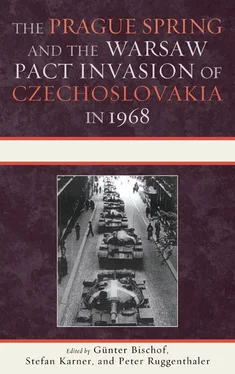THE U.S. COMMUNIST ALLY—FOR A SECOND TIME?
After the initial fear and insecurity, a few days after the invasion the Yugoslavs were convinced that their independence still mattered to the world. Early in September 1968, the British Foreign secretary and secretary of defense had agreed that a Soviet attack on Yugoslavia was unlikely. The Prague Spring had been “designed to maintain the status quo,” not to change radically the conservationist policy of the Warsaw Pact. 85Anyhow, an invasion of Yugoslavia would change the balance of power on the Old Continent. Therefore, during the meeting with the Americans, the British government concluded: “It should be made clear to the Russians that any attack on Yugoslavia would have the same effect as one on a member of NATO.” 86“The occupation of Rumania, serious though it would be, would not in itself touch upon vital Western security interests, but the invasion of Yugoslavia would be quite another matter.” 87The U.S. ambassador in Belgrade, Elbrick, after the interview with President Johnson on 14 October, once more stressed how “[t]he President cited our long tradition of assistance to Yugoslavia and expressed his admiration for the Yugoslav people and their dedication to freedom. The President made very clear his continuing interest in that country’s independence, sovereignty, and economic development.” 88
Since the break with Stalin in 1948, Yugoslavia had sometimes been called an “American Communist Ally.” The West tried to support Yugoslavianstyle communism and to widen the wedge between countries in the Socialist world. If possible, the aim was to develop trends in Eastern Europe detected in the National Intelligence Estimate on Yugoslavia in 1967. However, by the time that things started to change in Czechoslovakia, the overall political environment had already been changed. “[D]espite setbacks to our expectations for détente, the search for secure and peaceful East-West relations leading in time to a European security settlement is the only political goal consistent with Western values,” the British were reporting. 89That goal could have been achieved only with cooperation from Moscow. No one in the West was willing to start an even bigger quarrel with the Soviets, let alone serious fighting. 90The strategy of driving a wedge between the satellites and Moscow and establishing regimes like Tito’s was an old and unsuccessful plan. 91
In February 1948, Czechoslovakia was the last country in Europe to become Communist and a member of the Soviet Bloc. In June 1948, Yugoslavia was the first Socialist country to change sides, keeping the Socialist regime, but leaving Moscow. In 1956, Hungary was the first Bloc country to try to emulate the Yugoslav example. In 1968, Dubček seemed to be doing the same in Czechoslovakia. The Yugoslavs were helpful to both countries, although far less directly in 1968. Western propaganda was very outspoken during the Hungarian Revolution. One decade later, there was almost a silence. Although the “reawakening of political life” in Czechoslovakia was “obviously” in U.S. interests, as Western observers reported, a policy of nonaction carried the day. 92The West Germans, who were in charge of Radio Free Europe and Radio Liberty, chose to seem disinterested in the liberal developments in Czechoslovakia, in a move intended to avoid provoking the Soviets 93: “There is absolutely no evidence that either the State Department or the CIA took any measures to use the Prague Spring as a means of destabilizing or subverting the Soviet Bloc, in spite of constant Soviet propaganda about the sinister efforts of Western imperialism to do so.” 94
Enver Hoxha, the Albanian dictator and one of Tito’s archenemies, softened his position. Tirana had described the intervention in Prague as the “aggression of the Soviet revisionists.” 95The anti-Yugoslav campaign was stopped. Semiofficial signals from Tirana aimed at the improvement of relations between the two countries became numerous. Hoxha was afraid of the Soviets, especially since Bulgarians were printing maps of Greater Bulgaria with the San Stephan borders from 1878. 96Although the positive trend in Yugoslav-Albanian relations did not last for long, there were some lasting positive improvements. For example, ambassadors were exchanged in February 1971. 97
Once the Prague Spring was crushed, the Bulgarians, the most bellicose of all neighbors, refused to return the Yugoslav Army missiles they were supposed to mend. The Soviet Army was still on the very edge of the Pannonian Plain. Huge ferries, allegedly for the Soviet tourists, were being built in Odessa. 98Some of the most pessimistic analysts were thinking how the Soviets were aiming at creating a Greater Bulgaria at the Albanian and Yugoslavs’ expense. 99
The answer to the diplomatic problems was to start with an ambitious diplomatic game. The initiative from Addis Abeba to convene a conference of “peace-loving” countries in Belgrade and to condemn the Soviets was politely refused, though. Serious splits among the nonaligned countries had to be ironed out first. 100The Arabs were pro-Soviet because the Soviets were helping them in the Middle East. 101To revive the nonaligned countries’ unity and to avoid alienating them in the process became a new major task of the Yugoslav diplomacy. The Soviets were aware of the Yugoslavs’ attempts. Therefore, Soviet diplomats were informed of the “active antiSocialist and anti-Soviet” Yugoslav politics in Asia and Africa. The Soviets were to confront the “antisocialist” Yugoslav diplomats because advocating nonalignment, especially among the Socialist countries, was in their opinion nothing but an imperialist strategy aimed at harming the unity of the Socialist world. 102Only one year before the Prague Spring was crushed, Tito was in Moscow attending an advisory meeting of the Eastern European countries (minus Romania) which was coordinating the Yugoslav assistance to the militarily defeated Egypt in the Six Days War. 103After August 1968, Tito was, for a while, traveling only to the West, including an important trip to the Vatican. 104The (re)imposition of the rigid Communist regime in Prague showed the continuing importance of Yugoslavia for the West.
Dubček was probably inspired by Belgrade’s independence, but he was not directly influenced or led by Tito. Tito and Ceaus¸escu were eager to help the Czechoslovaks achieve not greater liberalism, but their independence form Moscow. While in Bulgaria the reforms of the 1960s were stopped, in Yugoslavia, they were sped up. 105After the end of the Prague Spring, Tito continued with a program of reforms in order to satisfy different nationalities. The Yugoslav People’s Army went though the most elaborate change. Ivan Gošnjak, ideologically rigid and fully devoted to Tito as commander in chief, was replaced. 106Territorial units were introduced, and each Socialist republic of Yugoslavia became partially responsible for its own protection. 107Some of the Marxist dissidents in Yugoslavia saw in the Czechoslovak events “the hope that the evolution they had argued for was now within their grasp…. Tito’s support for Dubček… permitted some of them to predict a second Yugoslav revolution.” 108Federalization and decentralization of the country led to the so-called Croatian Spring of 1970–1971. When Tito and his number two in the nomenclature, Edward Kardelj, were talking about the reformers they considered too liberal in the second-largest republic (and among some other politicians in all parts of SFRY), they would often call them “Dubček-ites” adding how they would rather see Russian tanks in Zagreb than tolerate their “Dubček-ism.” 109Yugoslav leadership was quick to forget how pro-Dubček they had been only a few years earlier and even more eager to adopt the Soviet language. With the crash of the Yugoslav “Dubček-ites,” it was all over. That’s when Yugoslavia actually died.
Читать дальше












